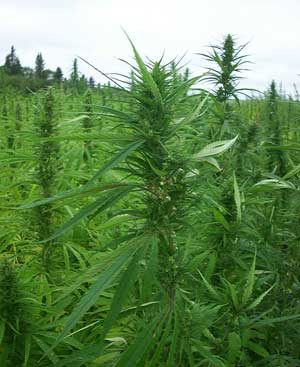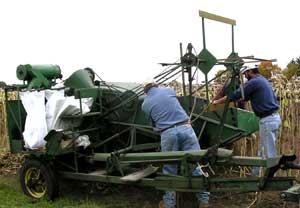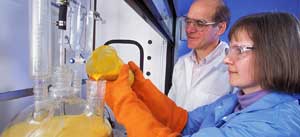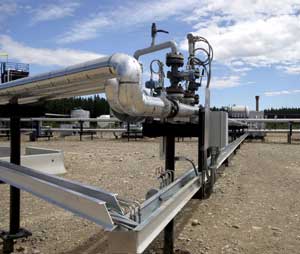February 2007
Featured

Waving the Palm Branch
By Holly Jessen
The use of palm oil to make biodiesel can dredge up images of barren acreage where lush rainforests once flourished. However, palm oils' use extends far beyond that of the biodiesel industry, causing demand for the product to continue to rise. To combat bad images and to keep up with growing demand, some in the industry have formed an organization charged with developing management practices that conform to a global definition of sustainable palm oil production.

Hemp Biodiesel: When the Smoke Clears
By Holly Jessen
Hemp literally produces a "green" product when it's used to make biodiesel. Despite the allure of the green-hued fuel, a close examination of the controversial crop reveals several barriers for its use as a biodiesel feedstock in the near future. However, as movers and shakers attempt to legalize hemp farming in the United States, those barriers could go up in smoke.

The Preventative Chemist
By Nicholas Zeman
If propylene glycol could be used as a primary component in the manufacturing of antifreeze, the demand for engine coolant in the automotive sector could be a valuable outlet for the glut of glycerin anticipated from the growing biodiesel industry. A University of Missouri professor has developed a process to convert glycerin to the nontoxic propylene glycol that could ease the minds of many biodiesel producers.

Budding Opportunities in Canola
By Ron Kotrba
Looking over the brilliant yellow fields of canola, which resemble a 19th century impressionist painting, the farmers responsible for this budding success see more than the glowing hue shining from the tender plant's flowers-much more. In fact, canola's opportunity to shine as a leading biodiesel feedstock in the United States has arrived, with a force so great that its presence can already be sensed.

Harnessing Sunflower Power
By Nicholas Zeman
Sunflowers could be a new source of feed and fuel for farmers in the northeastern United States. Experiments being conducted in New Hampshire and Vermont will determine whether the crop is a viable alternative for use as cattle feed and the on-farm production of biodiesel.

Canada Clears the Path for Renewable Fuels Advancement
By Dave Nilles
The Canadian Conservative party's federal government appears to be moving ahead with its campaign pledge regarding renewable fuels. A late December announcement provided hope for biodiesel and ethanol stakeholders, but the expansion of each industry may hinge on the details.

Campaigning for an Energy Future
By Jerry W. Kram
A grassroots initiative dubbed 25x'25 has an ambitious goal to increase the United States' use of renewable energy from 6 percent to 25 percent in less than two decades. While the initiative's coalition of environmental groups, farm organizations and energy producers advocates a wide range of renewable technologies, biodiesel, ethanol and biomass are all part of the plan. More than half of all the renewable energy in 2025 will come from biomass if the organization's predictions prove accurate-with prosperous implications for biofuels producers and rural communities.

Crazy for Camelina
By Nicholas Zeman
Montana Gov. Brian Schweitzer has referred to camelina as his new girlfriend. Although he can't put his arm around her, he believes that Camelina Sativa, a plant known primarily in North America as a weed, has potential as a feedstock for biodiesel production could be just the ticket to revive the economy in eastern Montana.

Perspectives on Fuel Quality
By Ron Kotrba
The importance of biodiesel fuel quality was hammered upon at the 2006 National Biodiesel Conference and throughout the past year. With the National Renewable Energy Laboratory's unsettling quality results fresh in people's minds, concerns over the condition of U.S. biodiesel supplies are mounting. Here's what the experts are saying about the state of quality in this industry today and what can be done to improve it.

Biodiesel on a Stick
By Anduin Kirkbride McElroy
Step right up and take a ride on the biodiesel-powered Ferris wheel! That's right folks, 350 million annual carnival-goers now have the opportunity to experience the power of biodiesel!

Pipeline Potential
By Anduin Kirkbride McElroy
In order for biodiesel to become a mainstream fuel, distribution costs have to be reduced and consumers need to have better access to the fuel. Pipelines, which are fast, reliable and inexpensive, offer a solution. Although some companies have conducted experiments to test a pipeline's feasibility, at this time it's not clear when or if it's a viable option for biodiesel.

Heat Management Systems: Install them Early, Install them Right
By Julie Ahner and Larry Kapalin
Improving Biodiesel Stability with Fuel Additives
By Glenn Kenreck

Legal Perspective
By Nancy B. Vollertsen and John Chanin
Employers at the Center of Immigration Enforcement







